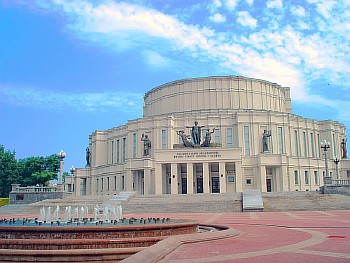
| Science Culture Cooperation Library Multimedia |
|
Main - - Culture - Architectural monuments - Minsk region Opera and Ballet Theatre in Minsk
Opera and Ballet Theatre in Minsk. It was built in 1934-1938 on the project of I. Langbard. Placed on a high point (at the former Trinity Hill), the theatre building is a spatial focus on the intersection of Independence Avenue and the water-green diameter of the city, visually expanding the central ensemble of the city. The original project was supposed to build a universal theatre building with a hall for 3000 seats (theatre of musical action), the idea of which was spread in Soviet architecture in the 1920's - early 1930's. Due to changes in the mid 1930's in the trends of the creation of theatre buildings I. Langbard redesigned the project to the decreasing the areas. The dynamism of the tier arrangement of buildings is reinforced with the vertical rhythm of the division of facades with vanes and narrow window openings. In the solution of the building there is connection with the Art Deco buildings, especially in project proposals for the use of monumental and decorative sculpture - relief and three-dimensional sculpture. In I. Langbard`s drawings the sculptural plastic is subjected to the light dynamic rhythm of architectural segmentations. The solemnity of the composition is reinforced with front entrance stairs. The core of the interior layout is the auditorium (in the result of reconstruction of 1944-1948 the amphitheatre was replaced by a tiered circuit with the stalls), which is surrounded by a semicircle of a lobby with cloakrooms on the ground floor and a spacious foyer on the first floor. The organization of internal spaces and interiors is subjected to the idea of creation a smart look of the building. In the decoration of the portal of the stage, foyer, lobbies moulded parts made by sculptor A. Bembel from I. Langbard`s sketches are used. In 2009, the reconstruction of the building (headed by the leader of the reconstruction team A.Shabalin) was completed. The technological modernization was implemented, new interiors were created, the artistic concept of which combines neo-classical themes, Art Deco and traditional ornamentation. The introduction of sculptures on the facade violated the rhythmic structure of vertical blades and balanced perception of the scale of the building. The shift of the monument to M. Bogdanovich to another place caused the loss of its urban role and organic perception in the complex with the theatre.
© National Academy of Sciences of Belarus, 2011
|

